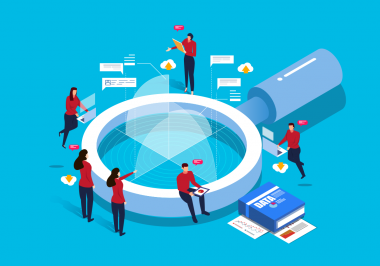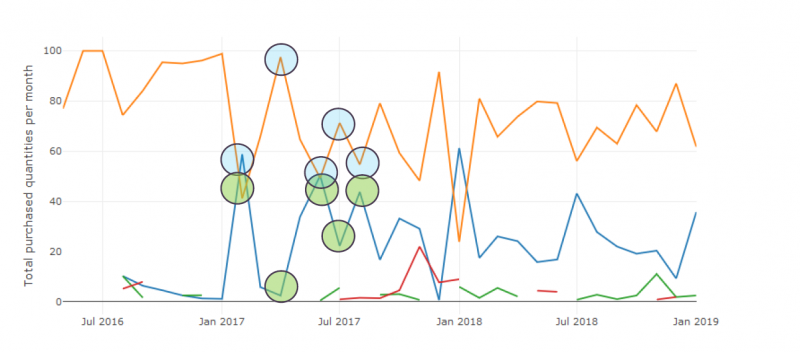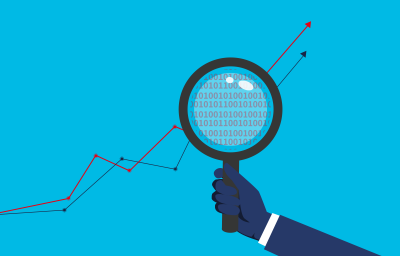Our secret to predict customer churn
Customers churn when they stop purchasing your goods or services. But how can you identify these customers and target them with personalized offers? Read more.
Expanding your customer base requires an investment from a company through marketing and sales representatives. If this is going well and new customers are coming in… then you are settled, right? But do you spend as much time and effort on the customers you already have? Do you keep track of their behaviour and know when you notice that they no longer buy from you? Detecting a customer considering leaving your customer pool on time allows you to incentivize the customer to remain loyal, perhaps with a personal message or offer.
Detecting customers about to leave early is the goal of customer churn prediction. At ML2Grow, we have a long tradition of making custom-made churn models that are smart enough to grasp your unique bond with your customers.
The importance of customer churn
Research shows that it costs five times as much to acquire a new customer than to keep an existing one. When nurtured correctly, existing customers are more likely to keep purchasing and become brand loyalists. Brand-loyal customers tell their friends about your company, are more likely to try new products, and are less likely to be chased away by a price increase.
Customer churn can manifest differently for different businesses. Still, it can be defined as when a customer unsubscribes from your service, ceases to purchase from you, or simply stops engaging with your brand. Customers leave for various reasons, and it’s an inevitable part of doing business.
Still, too many companies fail to address customer churn adequately. While usually no expense is spared to find and attract new customers, the same seldom applies to identifying customers ready to join your competitor. But how exactly can you focus your efforts on the right customer?
The impossibility of generalizing churn
One of the crucial questions is how to define customer churn in the first place, as it differs across businesses and situations.
Think about it as a relationship; every relationship has its frequency of interaction. Personal relationships can be intense, and people meet daily. Other relationships can have a much lower interaction frequency, whereas people who meet every few months or even once a year have significant relationships.
Relationships with different interaction frequencies will also end in different ways. In intensive relationships, a break of a few weeks or months will be regarded as remarkable and might signal that something in the relationship has derailed. In the context of other relationships, a silence of a few months or even a year will not be so uncommon.
The same story goes for relationships between companies and their customers. Customers communicate differently and with different frequencies, making it difficult to determine when a customer is about to say goodbye to you.

For example, subscription businesses that don’t allow pausing services are easy to define. It’s when customers unsubscribe. But for other e-commerce businesses, churn has a more vague definition of someone who stops purchasing and must be identified through other means.
It may involve defining churners statically based on their previous transactional history: someone who has a pattern of buying a few times every two months might be considered churned after six months of no activity.
Calculating an accurate churn rate is complex: it involves a lot of different formulas, effort, and interpretation, and to be honest, it’s quite a mess to do it the classical spreadsheet or business intelligence way. However, there is a more precise, accurate way to produce this information. As you may have guessed, data science and machine learning are the answer.
Making customer churn prevention a priority
Most companies know it’s essential to keep an eye on customer churn, but not all realize that owning customers from churning is directly linked to their profitability. Brands, especially those in a mature market, need to be acutely aware of when their customers are about to churn and try to win them back before they do. Customers now have lots of options; unless you’re first to the market, there’s a chance they’ll never come back.
From our experience, we see that most companies here are very aware of this but lack the technology and know-how to mitigate this risk accurately. For example, a basic but commonly implemented approach uses a primary, time-controlled metric. An example of this would be considered a customer as churned after three months. This one-size-fits-all approach ignores the interaction frequency of individual customers and customer needs and usually leads to poorly timed and ineffective marketing strategies. Besides, it completely breaks down if a customer only partially churns. In other words, they only stop buying some services or products.
When you automatically label customers as churned after a fixed time window, each customer’s behaviour in the context is not considered. Presume applying this approach to personal relationships. After three weeks of silence, calling your partner will give you a firm scolding. On the other hand, texting your colleague every two days during his summer holidays makes no sense at all.
Machine Learning is the key to making personalized solutions that do the heavy lifting.
For the data-driven marketeer, it’s now even easier to understand customer churn in ways that were impossible before. The exact impact customer data has on figuring out what email marketing messages will resonate with clients can be used to understand exactly how and why, and when customers churn. It’s no longer contested that machines are better at crunching numbers and probabilities than we are. Even more significant is that machine learning algorithms and modelling now translate into computer programs that can adapt to processed information. By using models that take into consideration recency, frequency, and monetary values of customers who have purchased before, not only can these models calculate customer churn, they can take it a step further and predict.
Machine Learning helps pick up purchasing behaviour patterns by sifting through enormous amounts of data and identifying common attributes of customer behaviour. This translates into identifying what kinds of customer action often lead to churn, even if that action is small or not easily measurable. The significance of predicting customer churn is not just the data provided, though it is remarkable. The true importance lies in what marketers and salespeople can then do with that information, which is to understand your customers better and reach out to them according to where they are in the customer lifecycle. It turns something informational or analytical and takes it further to make it actionable. Identifying which customers are at risk of churning helps you know when you need to send them an offer to win them back. Predicting when they will most likely churn gets you the information you need.

ML2Grow’s personalized approach to predicting customer churn
Advertisements and offers are essential to inform your customers better about your product range. This information finds its way to the customer through printed matter, online promotions and newsletters; only what articles do you recommend? The best possible selection of items maximizes sales, but each customer is unique, so a personalized selection is also necessary. The success of global players such as Netflix, Amazon or Facebook demonstrates the enormous power of this personal approach. We covered this in our previous blog post on boosting your sales with recommender systems.
If you combine this with our recommender system to get the timing of your offers just right, it amounts to some next-level severe customer interaction.
Please look at our use case with HLS in how we made a custom analysis, development and visualization platform for customer churn and how we integrated it with their sales team.
Predicting how likely a customer is to churn and when they will stir allows marketers to engage with relevant offers preemptively; bringing lost customers back into the purchasing cycle is the endgame here. However, people stop being customers for many reasons, which makes predicting this value extremely difficult.
More than ever, we see that general churn prediction algorithms offered out-of-the-box in data platforms do more harm than good, as they were designed to work in a general way and fail to understand the specifics of your unique company-client relationship.
For example, the following figure is taken from an actual use case where classical and general AI models fail to be truly intelligent systems.

The graph represents the quantities of items a specific customer bought over time, and the other lines represent different products. Do you notice something special? Indeed, whenever the customer purchased the orange product more, he ordered less of the blue product and vice-versa. In this setting, a classical out-of-the-box system would constantly predict individual product churn on one of the two items. In reality, however, the customer had been loyal for years and simply required more of the orange product when it was warm and more of the blue product when it was cold outside.
This is where our custom-made machine learning models come in to help make predictions. A specific churn risk is calculated individually per customer based on the knowledge and insights extracted from all your customer interactions.
This approach gives companies a deeper and more accurate understanding of each customer’s behaviour. Also, it gives you a much better chance to promote enduring customer relationships. Covered with this knowledge, companies can use personalized campaigns for customers at the right time to encourage loyalty and customer engagement.
ML2Grow has developed a method to accurately predict customer churn in which our unique approach for individual churn cut-off calculation is fundamental. This method has been tested and validated as an accurate and effective method.
Unburden yourself with our advanced churn prediction technology
We offer a cloud-based churn prediction platform which can also be combined with our recommendation engine: a risk assessment is made for each customer based on the periodic data of items sold. We demonstrate how to detect changing customer behaviour and identify customers who are about to cancel their subscriptions or purchases. We show how this can be avoided with a personalized adaptation.
Thanks to customer churn prediction, you maintain focus and avoid expensive efforts in customer acquisition getting lost. More specifically, ML2Grow has extensive experience in retail and wholesale with recommender systems (which provide customer-specific product recommendations, or the distributor specifically recommends customers who are open to a particular product) and automatically identifies churn predictions for the customers who are at increased risk. These techniques can also be used reverse: identifying the worst recommendations and the customers with the lowest risk of churn or, therefore, the highest acceptance rate.
Without revealing too much about the secret recipe of ML2Grow’s customer churn prediction technology, the approach relies on a specific individual churn cut-off calculation and a unique adaption to a more traditional classification problem. Using more advanced models allows us to capture extra information in the system, such as details about the client, the orders and the products or services sold.
Contact us today to learn more about how we can help you with ML2Grow’s Customer Churn Prediction technology. Allow us to easily optimize your marketing campaigns to increase existing customer spending and reduce customer churn.

